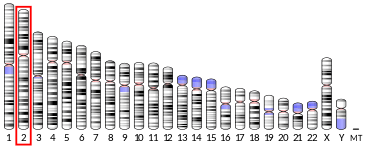GPR75
Probable G-protein coupled receptor 75 is a protein that in humans is encoded by the GPR75 gene.[5][6]
Function
GPR75 is a member of the G protein-coupled receptor family. GPRs are cell surface receptors that activate guanine-nucleotide binding proteins upon the binding of a ligand.[6]
GPR75 is currently classified as an orphan GPCR and several studies are underway to identify its ligand. In one study, the chemokine CCL5 (RANTES) has been shown to stimulate calcium mobilization and inositol triphosphate formation in GPR75-transfected cells.[7]
Recently, 20-hydroxyeicosatetraenoic acid (20-HETE), a bioactive eicosanoid formed by ω-hydroxylation of arachidonic acid has been shown to mediate its prohypertensive effects on the vasculature through activation of GPR75 (Gq) signalling.[8] This study by Dr. Schwartzman's laboratory at New York Medical college, one of the pioneers in study of 20-HETE biology, has opened new insights into the field of GPR75 pharmacology.
References
- GRCh38: Ensembl release 89: ENSG00000119737 - Ensembl, May 2017
- GRCm38: Ensembl release 89: ENSMUSG00000043999 - Ensembl, May 2017
- "Human PubMed Reference:". National Center for Biotechnology Information, U.S. National Library of Medicine.
- "Mouse PubMed Reference:". National Center for Biotechnology Information, U.S. National Library of Medicine.
- Tarttelin EE, Kirschner LS, Bellingham J, Baffi J, Taymans SE, Gregory-Evans K, Csaky K, Stratakis CA, Gregory-Evans CY (June 1999). "Cloning and characterization of a novel orphan G-protein-coupled receptor localized to human chromosome 2p16". Biochemical and Biophysical Research Communications. 260 (1): 174–80. doi:10.1006/bbrc.1999.0753. PMID 10381362.
- "Entrez Gene: GPR75 G protein-coupled receptor 75".
- Ignatov A, Robert J, Gregory-Evans C, Schaller HC (November 2006). "RANTES stimulates Ca2+ mobilization and inositol trisphosphate (IP3) formation in cells transfected with G protein-coupled receptor 75". British Journal of Pharmacology. 149 (5): 490–7. doi:10.1038/sj.bjp.0706909. PMC 2014681. PMID 17001303.
- Garcia V, Gilani A, Shkolnik B, Pandey V, Zhang FF, Dakarapu R, Gandham SK, Reddy NR, Graves JP, Gruzdev A, Zeldin DC, Capdevila JH, Falck JR, Schwartzman ML (May 2017). "20-HETE Signals Through G-Protein-Coupled Receptor GPR75 (Gq) to Affect Vascular Function and Trigger Hypertension". Circulation Research. 120 (11): 1776–1788. doi:10.1161/CIRCRESAHA.116.310525. PMC 5446268. PMID 28325781.




